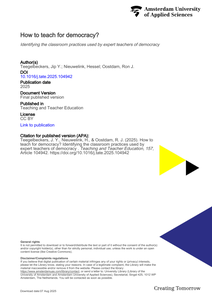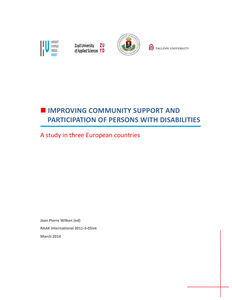This dissertation presents the results of a research project on unraveling the dynamics of facilitating workplace learning through pedagogic practices in healthcare placements. Supervisors are challenged to foster safe learning opportunities and fully utilize the learning potential of placement through stimulating active participation for students while ensuring quality patient care. In healthcare placements, staff shortages and work pressure may lead to stress when facilitating workplace learning. Enhancing pedagogic practices in healthcare placements seems essential to support students in challenging experiences, such as emotional challenges. This dissertation proposes approaches for optimizing learning experiences for students by highlighting the value of day-to-day work activities and interactions in healthcare placements, and shedding light on agency in workplace learning through supervisor- and student-strategies.
DOCUMENT

In today’s foreign language (FL) education, teachers universally recognise the importance of fostering students’ ability to communicate in the target language. However, the current assessments often do not (sufficiently) evaluate this. In her dissertation, Charline Rouffet aims to gather insight into the potential of assessments to steer FL teaching practices. Communicative learning objectives FL teachers fully support the communicative learning objectives formulated at national level and embrace the principles of communicative language teaching. Yet, assessments instead primarily focus on formal language knowledge in isolation (e.g., grammar rules), disconnected from real-world communicative contexts. This misalignment between assessment practices and communicative objectives hampers effective FL teaching. CBA toolbox The aim of this design-based PhD research project is to gather insight into the potential of assessments to steer FL teaching practices. To this end, tools for developing communicative classroom-based assessment (CBA) programmes were designed and implemented in practice, in close collaboration with FL teachers. Rouffet's dissertation consists of multiple studies, in which the current challenges of FL education are addressed and the usage of the CBA toolbox is investigated. Findings reveal that assessing FL competencies in a more communicative way can transform teaching practices, placing communicative abilities at the heart of FL education.
DOCUMENT

To stimulate democratic competences through teaching, it is necessary to have an understanding of actions and behaviors that are considered effective in teaching methods. In this study, we investigated these actions and behaviors, referred to as classroom practices, by interviewing 20 expert teachers of democracy in the Netherlands. We identified six relevant practices: meaningful embedding, providing multiple perspectives, thinking about solutions from divergent perspectives, independent information collection and presentation, taking socio-political action, and critical reflection on subject matter. We show how these practices are associated with democratic competences and provide examples of how the practices are implemented in teaching methods.
DOCUMENT

Extended Reality (XR) technologies—including virtual reality (VR), augmented reality (AR), and mixed reality (MR)—offer transformative opportunities for education by enabling immersive and interactive learning experiences. In this study, we employed a mixed-methods approach that combined systematic desk research with an expert member check to evaluate existing pedagogical frameworks for XR integration. We analyzed several established models (e.g., TPACK, TIM, SAMR, CAMIL, and DigCompEdu) to assess their strengths and limitations in addressing the unique competencies required for XRsupported teaching. Our results indicate that, while these models offer valuable insights into technology integration, they often fall short in specifying XR-specific competencies. Consequently, we extended the DigCompEdu framework by identifying and refining concrete building blocks for teacher professionalization in XR. The conclusions drawn from this research underscore the necessity for targeted professional development that equips educators with the practical skills needed to effectively implement XR in diverse educational settings, thereby providing actionable strategies for fostering digital innovation in teaching and learning.
MULTIFILE

This project builds upon a collaboration which has been established since 15 years in the field of social work between teachers and lecturers of Zuyd University, HU University and Elte University. Another network joining this project was CARe Europe, an NGO aimed at improving community care throughout Europe. Before the start of the project already HU University, Tallinn Mental Health Centre and Kwintes were participating in this network. In the course of several international meetings (e.g. CARe Europe conference in Prague in 2005, ENSACT conferences in Dubrovnik in 2009, and Brussels in April 2011, ESN conference in Brussels in March 2011), and many local meetings, it became clear that professionals in the social sector have difficulties to change current practices. There is a great need to develop new methods, which professionals can use to create community care.
DOCUMENT

Listening to students’ voices might result in the design of more effective learning practices, assuming that learning and teaching can be attuned more adequately in those practices. Therefore, research was carried out to investigate the characteristics of successful innovative learning practices using Web 2.0 technologies to establish to what extent they might serve as a model for learning practices in more or less similar contexts. Five learning practices were investigated through a range of processes including document analysis and by interviewing students. Additionally, a cross case analysis was carried out to track down success factors of teaching and learning with Web 2.0 technologies, and to find out to what extent these practices are contextual. The analysis showed the importance of co-production and co-creation in learning practices supported by the use of Web 2.0 technologies, and the crucial role of students’ motivation and teacher’s willingness to experiment with new learning practices.
LINK
LINK
Currently, various higher education (HE) institutes develop flexible curricula for various reasons, including promoting accessibility of HE, the societal need for more self-regulated professionals who engage in life-long learning, and the desire to increase motivation of students. Increasing flexibility in curricula allows students to choose for example what they learn, when they learn, how they learn, where they learn, and/or with whom. However, HE institutes raise the question of what preferences and needs different stakeholders have with regard to flexibility, so that suitable choices can be made in the design of policies, curricula, and student support programs. In this workshop, we focus on student preferences and share recent insights from research on HE students' preferences regarding flexible education. Moreover, we use participants’ expertise to identify new (research) questions to further explore what students’ needs imply for several domains, namely curriculum-design, student support that is provided by educators/staff, policy, management, and the professional field. Firstly, a conceptual framework on flexible education and student’s preferences will be presented. Secondly, participants reflect in groups on student personas. Then, discussion groups have a Delphi-based discussion to collect new ideas for research. Finally, participants share the outcomes on a ‘willing wall’ and a ‘wailing wall’.
MULTIFILE

Purpose – Against the background of current leadership theory, this research paper analyses and compares the leadership approaches of two outstanding leaders: Daniel Vasella, chairman of the leading Swiss pharmaceutical organization Novartis and Ricardo Semler, owner of the Brazilian conglomerate Semco. In contrast to many rather abstract, unpractical and pointlessly theoretical papers on leadership this analysis provides a more applied view of leadership by means of the life history approach delivering insight into both leaders’ development and leader personality. Methodology/approach – First, this paper locates the ideas and practices associated with the term “leadership” as a concept through theories that have developed over time and shows how the practices of leading can be derived and understood through chosen theories. Based on this, the specific characteristics and career paths of both leaders are presented and compared so that a final analysis of their leadership approach can be done. The paper is based on secondary sources such as peer-reviewed business journals and literature on leadership. Information about both leaders and their approach to leadership is gathered mainly from published interviews with them. Additional information on Semler is taken from his autobiography. Conclusions – It is difficult to identify an “essence” of leadership, whether that takes the form of personality characteristics or traits, charisma, the ability to transform people or organizations or a brain function. All presented theories of leadership seem to have their raison d’être. Both Vasella and Semler apply a combination of different attitudes and behaviours that characterize their leadership style containing elements of transformational, charismatic, ethical, servant and authentic leadership.
MULTIFILE

Context When the pandemic hit the world, teachers were forced to change their education from onsite to virtual overnight Understandably, teaching quality decreased in the beginning, as there was little experience in how to adapt the educational design Zuyd University of Applied Sciences ( recognized the problem that teachers were on different didactic and pedagogical levels when it comes to online education Unfortunately, the pandemic made it hard for teachers to connect with each other In the Domain of Health and Welfare, this led to the idea of establishing a professional learning community A professional learning community ( can be seen as an informal group of people who share knowledge and experiences among each other on a common topic they are all highly interested in Zuyd’s vision “passion for development” sets a good basis for the start of such a community. Steps we took In order to find out how a professional learning community can look like in Zuyd, the following steps were taken Firstly, we collected and evaluated literature and best practices around the topic Based on our findings we developed an interview guideline and conducted interviews with eight teachers from the Domain of Health and Welfare Throughout the whole report a SWOT analysis was performed with the literature and best practices filling opportunities and threats and the interviews providing content for strengths and weaknesses Main findings From these sources, we derived enablers for a successful learning community, which led to recommendations for Zuyd on how to strategically position, implement and organize a PLC One of our major recommendations is to make didactic and pedagogical skills an important topic within Zuyd in order to strategically implement the learning community into Zuyd’s strategy Furthermore, we recommend giving the lead in organizing and facilitating the PLC to the blended learning task force To collect a diverse set of interested employees to the core group, the educational managers should personally approach teachers that might be interested The sense of urgency around the topic needs to be addressed regularly through the directors of the Domain, the task force of blended learning, as well as the PLC itself In this way, interest in the topic of didactic and pedagogical skills and blended learning can be enhanced In the report we go into greater detail on how to organize and apply these recommendations. We are convinced that implementing these steps will pay off in the future and will successfully enhance competencies on blended learning and didactic and pedagogical skills through knowledge exchange.
DOCUMENT
